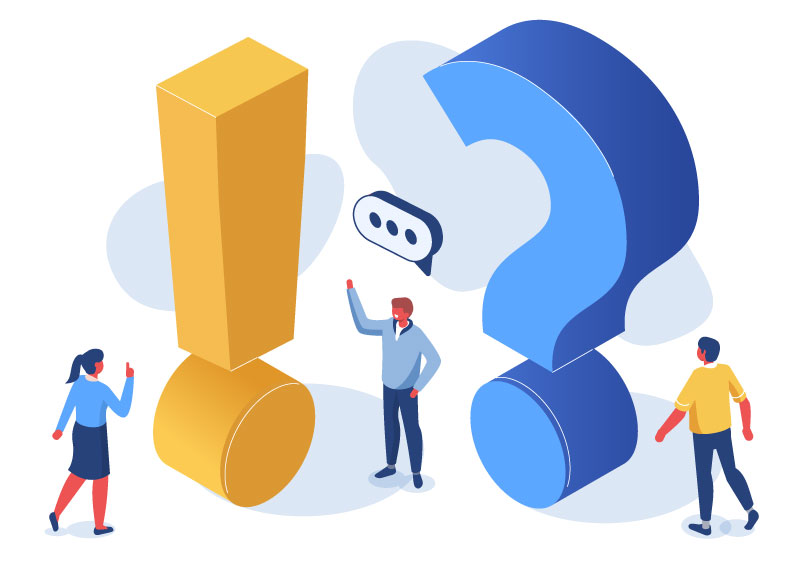Are you interested in digital marketing, but it’s not your area of expertise? Do you have a lot of questions and would like some expert advice?
For the first edition of our FAQ, we’ve decided to answer the 5 questions most frequently asked by our customers. We hope this will help a lot of apprentice marketers!

1. Should I leave my campaigns running all the time?
E-marketing is not just about short, one-off actions; it’s also about campaigns that are designed for the long term, or even the very long term.
Did you know that always-on marketing (constant engagement with your community) is essential to a successful strategy? It allows you to have a continuous online presence and capture the attention of users at all times.
The advantages of these campaigns are not negligible, as they save time and resources and, in the long term, build loyalty among your audience!
However, you shouldn’t neglect one-off and seasonal campaigns either, which allow you to boost your visibility at key times of the year, for example when your customers are actively looking for gifts for the festive season. In short, the perfect combo is a mix of these two types of campaign.
2. What budget should I invest in Google Ads?
Setting your Google Ads budget isn’t easy, but there are a few things you can do to make it easier. Google Ads campaigns are based on a bidding system. Different bidding options are available to you depending on your priorities (priority for clicks, impressions, conversions, etc.).
For your first SEA campaign, it’s best to start with a cost-per-click (CPC) strategy. However, you should be aware that the CPC is not stable and fluctuates according to various criteria such as the competition, the margin, the quality score and the positioning of the ad. So it’s vital to know what the market is like before you take the plunge.
As well as analysing the market, you need to set your objectives in order to define the budget to allocate to your campaign(s). Visibility, traffic, leads, conversions… Depending on the objective you choose, the amount to invest will be different. To help you do this, Google Ads provides two very useful tools: the performance planner and the keyword planning tool.
Using these tools, you can define a keyword strategy and get an idea of the forecast results in relation to your daily budget. However, the advice and experience of professionals can be a real asset in maximising the results of your campaigns!
3. How do you calculate return on investment?
One of the most recurrent problems in e-marketing is the lack of visibility of return on investment. Many companies launch campaigns on Google or social networks without really knowing how they are going to quantify the results obtained.
And yet, reporting and ROI measurement are precisely one of the great advantages of digital. Thanks to tracking and retargeting tools, e-marketing is a very powerful tool.
ROI is the difference between the revenue you earn from your campaigns and the money you spend on them. It can be measured using various tools, such as the Facebook pixel, LinkedIn’s Insight Tag, Google’s Global Site Tag and other tracking codes that can be integrated into your landing page.
There are a number of factors to take into account when calculating your ROI. For example, it’s interesting to obtain leads, but are they qualified? Will they ultimately lead to a sale? The adage “quality is better than quantity” is clearly to be preferred here.
By keeping good track of conversions, you will be able to identify the real results obtained from your campaigns. And don’t forget that visibility and engagement are also important results, even if they don’t bring you direct revenue.
4. How should a campaign be structured?
Implementing an e-marketing strategy requires structured thinking. For a campaign to be effective, apart from the question of budget, you first need to define an objective, an audience and a message.
One of the key points to remember in e-marketing, whether on social networks or Google: 1 objective = 1 campaign. What’s more, the various tools don’t allow you to choose more than one.
Next, you need to define your audience. There are many possibilities in terms of targeting: interest-based audiences, retargeting people who have visited your site or interacted with your page or advertisements, and more. Your audience derives from your objective. For example, a campaign aimed at acquiring new followers on Facebook should obviously exclude users who already follow your page.
Finally, depending on your objective and target audience, you need to think about the messages you want to get across. You need to adapt your message so that it is relevant to the user who will see it, and the landing page on which they land must also be linked to it.
To maximise the effectiveness of a campaign, the ideal is to be able to target as precisely as possible, both in terms of the audience and the message. You can’t target the whole world with a limited budget and a single campaign. So the bigger the budget, the more you’ll be able to define different objectives, split your strategy into different campaigns and target different audiences.
Need help finding your way around all the e-marketing features on Google or social networks?
5. What’s the best way to reach your customers via digital marketing?
The answer to this question is very simple: via an omnichannel strategy and the identification of the channels used by your audience. In short, this strategy consists of using and interconnecting all the contact points available to reach users. There is no miracle solution, but here are a few tips from our experts:
- Benchmark and gauge the competition
- Draw inspiration from winning strategies
- Adapt your communication to suit the channel and the target audience
Here are the first steps to effective communication. Then you need to analyse the results and adapt your strategy according to what works and what doesn’t.


Passionate about social networks and writing, Mathilde is part of our team of experts in Community Management and Social Media Advertising. As the guarantor of DJM’s and its partners’ e-reputation, she makes it a point of honor to follow the latest trends related to social networks and the digital sector at large.



